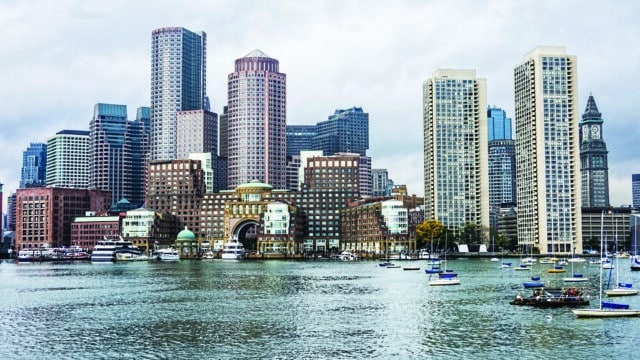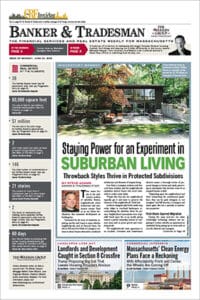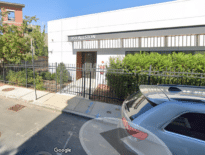
Harbor Towers condominium owners will spend $20 million on a flood barrier system designed to protect the Boston waterfront property from rising seas. Photo by Steve Adams | Banker & Tradesman Staff
After a nor’easter in 2018 pushed flood waters within 6 inches of the Harbor Towers condominiums’ lobby, trustees decided they could no longer ignore the effects of climate change.
A $20 million project this year will bolster the 40-story luxury skyscrapers’ ground floor coastal defenses, adding permanent glass and concrete flood barriers between 24 building columns to protect the ground floors and subterranean mechanical rooms. Next month, work will begin on the largest-scale project to protect a Boston residential property from sea level rise.
“So far, we have had very good support from the residents, because this will preserve and possibly even increase the value of their units,” said Norman Meisner, chair of the board of trustees for Harbor Towers One.
Public projects that would protect Boston’s 47-mile coastline from sea level rise are still years away from groundbreaking, and come with potentially staggering costs. In the meantime, private property owners are starting to take resiliency strategies into their own hands.
Planning for the Harbor Towers project began shortly after a pair of nor’easters in 2018 that caused widespread flooding, inundating Long Wharf, the MBTA’s Aquarium station and the Rose Fitzgerald Kennedy Greenway. The extent of the flooding alarmed residents of the 1970s Harbor Towers complex, which currently lists units from $700,000 to $3 million.
The condo association hired Elkus Manfredi Architects to study potential fixes for the two 40-story buildings, including relocation of mechanical equipment to the penthouse levels. But that would have required running 15 new utility lines throughout the concrete building cores and was rejected as infeasible, Meisner said.
Reading-based engineering firm Weston & Sampson then recommended fortifying the building base. Financed through a one-time supplemental fee for condo owners, the project is expected to begin in April and last 12 months, Meisner said.
The most extensive work will take place on the north and east sides of Tower One at 85 East India Row, located steps from Boston Harbor. Reinforced 16-foot-tall glass inserts will be installed between the building’s structural columns on the ground level, and are designed to withstand storm surges up to 6.5 feet, Meisner said.
A combination of glass and concrete flood barriers will be installed on the south and west sides of Tower One’s ground floor and its sibling at 65 East India Row. Portable steel flood barriers also will be available for installation within hours as storms approach.

A rendering showing the area of downtown Boston that could be flooded by a so-called “100-year storm” by 2030 as sea levels rise and the severity of ordinary storms worsen. It’s estimated that Boston has a 10 percent chance of being hit by a 100-year storms by 2033. Image courtesy of the Wharf District Council
A Case Study for Coastal Resilience?
Commercial landlords including Tishman Speyer and BXP have installed temporary flood barriers at their Boston waterfront properties in recent years, but the Harbor Towers project represents a milestone reflecting residential property owners’ growing concern over flood risks.
“What they have been through has been extremely educational to the rest of the community,” said Marc Margulies, president of the Wharf District Council, a neighborhood property owners’ group that is overseeing resiliency planning for the downtown waterfront.
Currently, Boston’s zoning code doesn’t explicitly regulate resiliency projects, making the Harbor Towers project something of a test case, Margulies said. The local permitting process for Harbor Towers took approximately 18 months, Meisner said.
A city councilor warns that Boston needs to streamline its resiliency permitting to reflect the climate change threat.
District 1 Councilor Gabriela Coletta Zapata spotlighted the “long periods of review and bureaucratic delays” associated with proposed retrofits of waterfront properties. In a September report, Coletta Zapata said the permitting process for flood barriers and other resiliency projects should be streamlined, citing the Harbor Towers project as an example of lengthy delays.
In a statement this week, Coletta Zapata’s office said it’s working with City Hall agencies on the issue, including projects on urban renewal parcels that have land disposition agreements complicating the process.
“We have many LDA properties in Charlestown, the North End and the Wharf District and anticipate more approval delays may arise for climate resilient projects without an expediting mechanism or tool in place,” spokeswoman Elizabeth Sanchez said in an email.
Flood control projects are subject to review under Boston’s Coastal Flood Resilience zoning overlay district, which was adopted in 2021. Approximately 200 projects have been approved under the zoning since then, according to a spokesperson for the city’s Environment Department.
Such projects also may require approval from the Boston Planning Department and Conservation Commission, along with building permits.
“We applaud Harbor Towers for understanding the risks of sea level rise and coastal storms, particularly properties that are already experiencing flooding or are within the near term flood path projections,” the city’s Energy Department said in a prepared statement.

Property owners in the downtown and North End are banding together to work with environmental consultants, providing lot-by-lot property data they hope will accelerate the city’s timetable. iStock photo
New Study Focuses on North End Residents
Neighborhood-wide flood defenses are still years away from groundbreaking, pending the completion of detailed design studies. But property owners in the downtown and North End are banding together to work with environmental consultants, providing lot-by-lot property data they hope will accelerate the city’s timetable.
After studying the Wharf District area near the New England Aquarium, engineering firm Arup estimated that a 1.5-mile-long flood barrier would cost $877 million but prevent $3.9 billion in projected property damages by 2050.
Now, a year-old neighborhood nonprofit with a climate focus is working with Arup to calculate the costs and benefits of a flood barrier in the waterfront area between Commercial Wharf and Battery Wharf.
The North End Waterfront Climate Alliance hired Arup to survey approximately 16 property owners on existing conditions, after receiving a $250,000 grant from the Massachusetts Office of Energy and Environmental Affairs. The properties include marinas and condominium buildings such as Commercial Wharf and Lewis Wharf, NEWCA President Cheryl Delgreco said.
Preliminary findings indicate the need for a substantially redesigned waterfront. The Boston Harborwalk, which functions as a flood barrier, might have to be elevated by seven feet in some areas to meet 2050 flood projections, said Derek Anderson, an associate civil engineer at Arup.

Steve Adams
“We are coming to the meetings and laying out the options: ‘Do you want a big sea wall that cuts people off from the water? Do you want to let the water in?’” Anderson said. “We’re not at the point yet to say it’s going to be letting an area flood, or trying to keep the water out.”
Like the Wharf District property owners, North Enders hope to tie the findings into city and federal studies of the entire waterfront, potentially leading to construction of unified flood defenses.
The city is partnering with the U.S. Army Corps of Engineers on comprehensive coastal flood control study, in a step that is necessary to receive federal funding for projects. Previous city-sponsored climate studies have estimated the cost of flood prevention at over $4 billion.
The Army Corps will begin presenting potential designs to the public this year, but the study is expected to run through 2028, according to a December 2024 presentation by city and federal officials.
“We think given the resources that are available, the Wu administration is demonstrating great progress,” Conservation Law Foundation President Bradley Campbell said. “But there remain financing challenges, especially now that all federal funding is up in the air given the Trump administration’s early actions.”
One model, which has been proposed by former legislator William Golden, would create a regional agency to oversee resiliency public works projects.
“The model we already have in place through the MWRA for wastewater could be adapted to address these issues,” Campbell said. “But that obviously requires the support and engagement of the legislature.”
Editor’s note: This report has been updated to reflect the size of the grant to the North End Waterfront Climate Alliance was $250,000.






